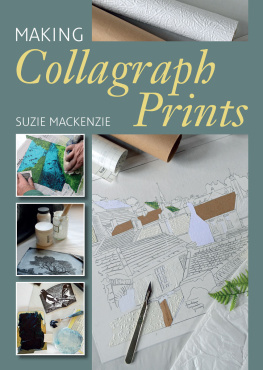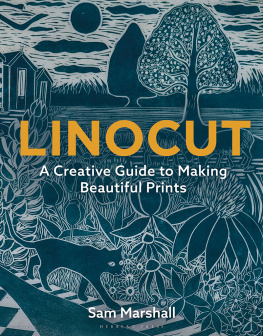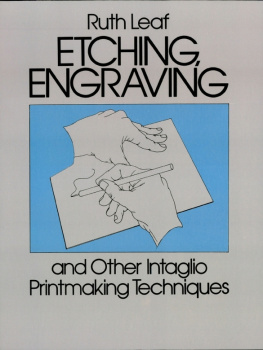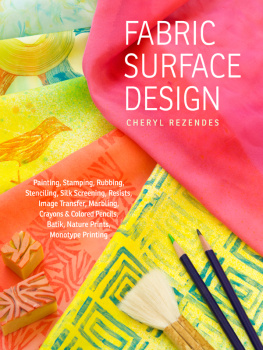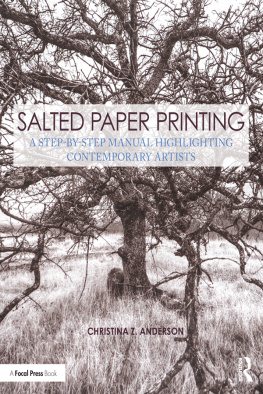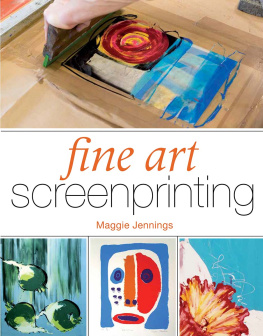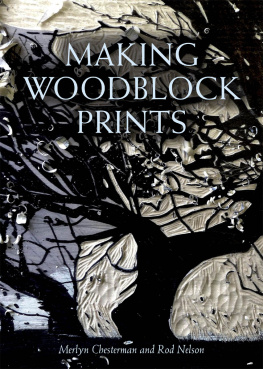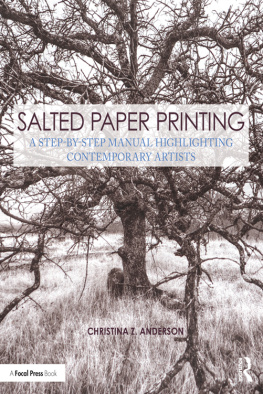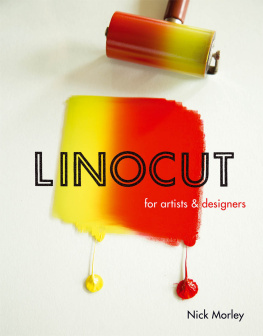MAKING
Collagraph
Prints

MAKING
Collagraph
Prints
SUZIE MACKENZIE

THE CROWOOD PRESS
First published in 2019 by
The Crowood Press Ltd
Ramsbury, Marlborough
Wiltshire SN8 2HR
www.crowood.com
This e-book first published in 2019
Suzie MacKenzie 2019
All rights reserved. This e-book is copyright material and must not be copied, reproduced, transferred, distributed, leased, licensed or publicly performed or used in any way except as specifically permitted in writing by the publishers, as allowed under the terms and conditions under which it was purchased or as strictly permitted by applicable copyright law. Any unauthorised distribution or use of this text may be a direct infringement of the authors and publishers rights, and those responsible may be liable in law accordingly.
British Library Cataloguing-in-Publication Data
A catalogue record for this book is available from the British Library.
ISBN 978 1 78500 582 4
Acknowledgements
My heartfelt thanks go to the printmakers who have been generous enough to allow their work to be included in this book. To all the printmakers and print technicians who have shared techniques and procedures with me over the years, thank you, with a special mention to the following teachers from whom I have learnt so much: Dave Gibbs at Loughborough Universitys School of Art and Design, who first introduced me to collagraph, along with many other printmaking techniques; Brian MacBeath at Highland Print Studio, whose teaching encouraged my obsession; Nicholas Devison at Edinburgh Print Studio for his invaluable tips and individual approach; and last but not least Charles Shearer at Leicester Print Workshop and at Orkney College UHI, for his inspirational printmaking magic. Grateful thanks go to Cheryl Bickham for single-handedly setting up and running the wonderfully supportive and exciting Collagraph World Wide Facebook group, an irreplaceable resource for those working in the medium, through which I have been able to connect with many of the printmakers featured in this book and to gain a deeper understanding of some of the processes outlined here. And finally, thank you from the bottom of my heart to Richard, without whose unfailing support in so many ways this book could never have been written.
CONTENTS
INTRODUCTION
Collagraph is a relatively recent and highly versatile printmaking technique that, in essence, involves building a printmaking plate from readily available non-toxic materials. The plates can be inked and printed using the relief method, where ink lies on the upper surfaces of the plate, or, more usually, using the intaglio method, where ink remains in the recesses of the plate; using a combination of both methods in the same print; or using no ink at all to create an embossed image (also known as a blind emboss). It is a highly accessible process, in that the plates themselves can be constructed easily at home from everyday materials, and although intaglio printing requires the use of an etching press, plates constructed for relief printing can be printed by hand without a press. Collagraph has the potential to be highly expressive in allowing for textural effects that are not easily achievable with other types of printmaking. By careful choice of inks and adhesives, this method can be completely non-toxic and environmentally friendly, particularly if the materials used to build the plates are recycled.
It is not possible to pinpoint the exact beginning of collagraph as a printmaking medium; like so many innovations in art and other fields, experiments began independently in different locations across the world. In the late nineteenth century, French sculptor Pierre Roche was experimenting by taking prints from a moulded plaster matrix; in the early twentieth century Picasso, Braque and others began to experiment in collage, anticipating what was perhaps an inevitable development in printmaking. Innovations in modern adhesives, fillers and acrylics had already encouraged further experimentation by the time artist Glen Alps was credited with first coining the term in 1950s America.
The words own origin is from the Greek words kola, or glue, and graphikos, meaning something drawn or written; although sometimes spelled collograph, the original Greek should give an indication of the standard spelling. To add confusion, the technique is also occasionally referred to as collotype, which in fact is a completely separate, early photographic medium that bears no relationship to this printmaking method.
The versatility and expressiveness of collagraph lies in the huge variety of approaches to plate-making. The plate can be built up by affixing textures to it; it can be cut into; it can be initially roughened, and then worked back into with artists mediums; it can be worked in a very painterly fashion, or in a controlled, graphic style; and of course any combination of these techniques, and more. There has been much discussion regarding what exactly the term collagraph covers its etymology suggesting simply a plate with materials stuck to it. Different approaches, all subsumed under the term collagraph, include silk aquatint or silk mezzotint, drypoint, chipboard relief, carborundum print and card cut but the widest possible approach has been taken in this book. As a result you will find discussion of a number of different ways of working that fall under the experimental printmaking ethos of collagraph.
One of the great joys of this medium is its flexibility. The intention in writing this book was not to attempt to construct a definitive manual, but rather a guide to one technique that can create successful prints in a simple way, while at the same time giving an overview of some of the many other possible approaches, within the limitations of this slim volume. Other makers of collagraph embrace very different methods of working; there are many ways of making, and personal choice and growing experience will enable the reader to build on some of the suggestions made here, finding his or her own way with the medium. Collagraph has been referred to as the poor mans etching, but it is the authors aim in this book to introduce what is arguably the richest of all printmaking mediums.
CHAPTER ONE
MATERIALS AND EQUIPMENT
Plate-Making Materials
The Base Plate
When making collagraphs, the surface that the print is taken from is usually called a plate. Acrylic sheet, sheet metals such as aluminium or steel, and wood-based materials such as thin plywood or 3mm MDF all work well as a base for collagraph. Cardboards such as environmount, greyboard, millboard, paper drypoint plates and standard mountboard which comes in textured and untextured finishes make excellent plates as they are inexpensive as well as easy to cut, work, and glue textures to. Boards made from layers of paper laminated together, such as mountboard or environmount, are ideal for the cutting-and-peeling approach to platemaking.

Materials for Adding to the Plate
When beginning to experiment with collagraph, there is often an overwhelming desire to collect anything with an interesting texture to add to the plate. However, there are a couple of things that should be borne in mind at this point; firstly, remember that anything selected must be stuck firmly to the plate some materials, for example fresh plant material, are difficult if not impossible to stick securely; and secondly, that chunky or heavily textured materials of any kind should be avoided paper-thin is best. Thicker items and anything absorbent string, fabric, corrugated cardboard, plant stems will trap excess amounts of ink either within the material itself or around the edges and will cause pools of ink to spread across the print. While there are ways of dealing with these items to create successful prints from them, such as slicing them lengthwise or embedding them in medium, it is easiest to avoid them when starting out and save them for exploration once you have more experience. Further, it takes some time to begin to appreciate which items really will print in interesting ways some very promising-looking textures can make uninteresting printed areas, while other quite unpromising materials prove exciting when printed. Experience will help you to assess these with more success as you progress. The following materials all work well for plate-building:
Next page
